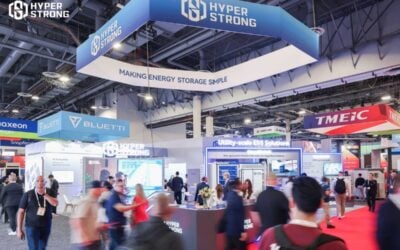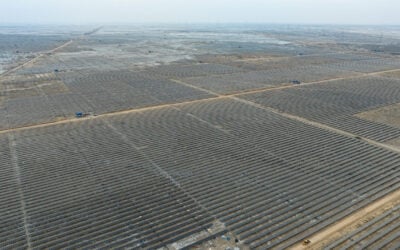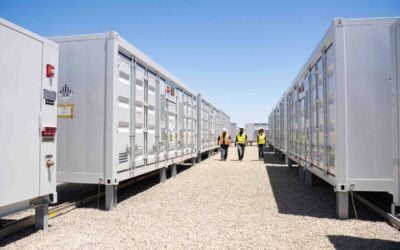VIZn Energy’s battery performance was compared favourably to combined cycle gas turbines in acting as peaker plants. Image: VIZn Energy.
Makers of flow batteries have redoubled their efforts to make the technology the leading choice for utility-scale storage applications, with one installing the largest such system to date in Europe and North America just a few days ago.
A 1MW battery with maximum energy capacity of 4MWh was commissioned last week by UniEnergy Technologies, for utility company Avista Utilities in the city of Pullman, Washington. The battery system, branded ‘Uni.System’ by the manufacturer, will provide multiple services, including load shifting, frequency regulation of the grid and conservative voltage regulation on the local Turner distribution circuit.
In other words, the system will manage grid-balancing functions as well as load management. Interestingly, Avista’s client for the project, Schweitzer Engineering Laboratories (SEL), is itself a specialist in grid equipment, including protective relays. UniEnergy claims it to be the largest flow battery operating at present in either North America or Europe.
Meanwhile, as UniEnergy Technologies and Avista plugged in the project, which was partly funded by local authorities through the Washington State Clean Energy Fund, another flow battery maker turned its sights on Europe’s energy storage potential.
Enjoy 12 months of exclusive analysis
- Regular insight and analysis of the industry’s biggest developments
- In-depth interviews with the industry’s leading figures
- Annual digital subscription to the PV Tech Power journal
- Discounts on Solar Media’s portfolio of events, in-person and virtual
Redflow, headquartered in Australia, has entered the European market. The company claims to have been the first flow battery maker to have achieved large-scale manufacturing through a deal with Flextronics. Redflow CEO Stuart Smith cited a number of potential avenues for the company to take in its European advance.
“As we expand worldwide, we know our battery technology is ideal for applications required by the European market, such as on- and off-grid remote rural power, telecommunications BTS sites, utility energy, commercial applications and renewable integration,” Smith said.
Redflow will operate through a Germany-based subsidiary Redflow Europe. The company says it will supply system integrators in Europe with its zinc-bromide electrolyte flow batteries, which can be used for multiple hours and have a 100% depth of discharge. The battery maker also guarantees the energy throughput performance of its products.
There has been much debate within the industry about the comparative suitability of flow batteries versus lithium-ion at large scales, not least of all since Tesla announced that its line of utility-ready lithium batteries would come at a price of US$250 per kWh, although this figure is not thought to include installation or additional hardware costs. Others, such as NEC ES, are already using lithium batteries for large-scale applications.
Flow batteries and lithium are increasingly becoming rival technologies for grid-scale energy storage applications. Image: Tesla Energy.
Another flow battery maker, VIZn Energy, which has among its board of advisors solar industry veteran Jigar Shah, is also hoping to make inroads into the European market. VIZn made some industry headlines earlier this year when a whitepaper produced by grid-scale energy consultancy Energy Strategies Group (ESG) favourably compared the company’s flow batteries’ performance to combined cycle gas turbines in acting as peaker plants.
The whitepaper’s author, Chet Lyons, said the batteries are “an economically attractive substitute for many simple cycle gas-fired combustion turbine peaking plants, especially when deployed on a distributed basis and owned and operated by the electric utility”.
At Intersolar Europe at the beginning of this month, PV Tech spoke to VIZn Energy’s vice president of sales, Del Allison. Allison said VIZn had started as a US Department of Energy (DoE) funded project that ran with aerospace and engineering firm Lockheed Martin acting as its primary for over eight years. VIZn eventually acquired the rights and product and has set out on its own.
Allison spoke about what he sees as the advantages of flow battery technology in competition with lithium at larger scales. VIZn’s battery is multi-service, he said, meaning that as well as pursuing opportunities to provide frequency regulation to the grid, it can also be used simultaneously to off-take power from solar farms, for instance, without the wear and tear and potential issues with heating and cooling that can be associated with rival technologies.
Flow batteries store liquid electrolytes in tanks, as opposed to lithium-ion batteries which use solid materials for electrolytes. This means that not only can the amount of energy be scaled up, it also reduces the proportion of flammable materials in use.
“I think initially there is direct competition. But remember, technologies like lithium are pretty ideal for EVs, because you get a very high energy density, which works well in automobiles,” Allison said, on the subject of lithium-ion versus flow battery.
“But when you start thinking about deploying it in megawatts, not small kilowatts, suddenly the number of Li-ion batteries that you have to put in – failure rates are generally multiplicative not additive, so the number of connection points that you have to make have an impact on the reliability.”
Allison also claimed the durability of the flow battery to be greater, coping with much higher charge and discharge rates and more frequent cycling than other battery types.
“The other challenge is the fundamental chemistry. How many times a day can you use it? Does it have an impact on the life expectancy of a product? And the answer is yes, in both cases it does.
“Whereas our battery, we encourage people to use it. It doesn’t deplete the electrolytes, it’s not outgassing hydrogen or other things, it’s non-toxic. If there’s a fire it puts out the fire – it’s non-flammable.”
According to Allison, while lithium-ion batteries may still remain cheaper at point of purchase even at large scales than its flow counterparts, he claims factors including the relative costs of maintenance and servicing and the fact the battery can be used to provide more than one revenue stream at a time, need to be taken into account over the full lifetime of the battery.
“[Using a flow battery], my cost of electricity over 20 years will be dramatically less than a lithium solution, my operations and maintenance (O&M) is dramatically less, again we have access to a 100% charge, most lithium remains at 60%, 70% on the daily sheet, so that’s a huge difference, especially if you’re cycling the battery multiple times a day.”





